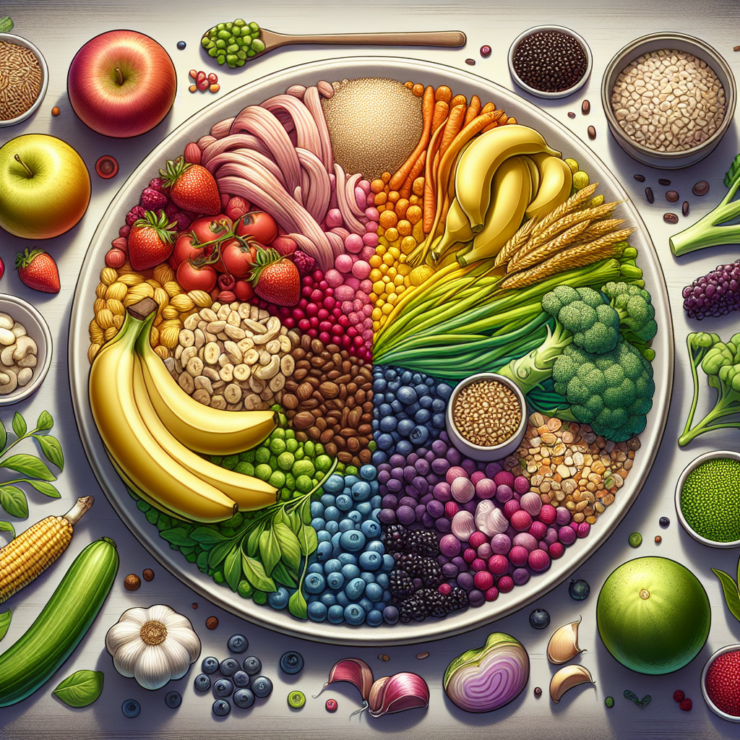The Importance of Gut Health
The human gut is a complex ecosystem, home to trillions of microorganisms that play a crucial role in overall health. Understanding this internal environment, commonly known as the microbiome, is essential for maintaining the delicate balance required for optimal bodily functions.
Understanding the Microbiome
The microbiome consists of bacteria, viruses, fungi, and other microscopic living things. These organisms are found primarily in the intestines and on the skin. While the thought of bacteria often brings the idea of disease, many of these microorganisms are beneficial and necessary for a healthy body.
The microbiome assists in various functions, including food digestion, vitamin production, and protection against pathogens. The diversity and number of these organisms can be indicative of a person’s health; a more diverse microbiome is often associated with better health outcomes.
| Function | Microbiome Role |
|---|---|
| Digestion | Breaks down fibers and complex carbohydrates |
| Vitamin Production | Synthesizes vitamins like B and K |
| Immune System | Trains immune cells, regulates inflammation |
The Role of Prebiotics in Gut Health
Prebiotics are compounds in food that induce the growth or activity of beneficial microorganisms such as bacteria and fungi. They are essentially the food for the good bacteria in the gut. Consuming prebiotics can help improve the balance of these microorganisms, which in turn supports the digestive system and overall health.
Prebiotics are typically non-digestible fibers that withstand stomach acid and reach the colon where the microbiota resides. By selectively stimulating the growth of beneficial bacteria, prebiotics help improve bowel regularity, enhance immune function, and may even reduce the risk of certain diseases.
Understanding the role of prebiotics in gut health is a stepping stone to recognizing the importance of a balanced prebiotic foods list in one’s diet. These components are crucial for nourishing a healthy microbiome and fostering a symbiotic relationship between humans and their internal ecosystem.
What Are Prebiotics?
Defining Prebiotics
Prebiotics are specific plant fibers that humans cannot digest but are highly beneficial for the good bacteria living in the gut. These substances serve as nourishment for the gut microbiota, the diverse community of microorganisms residing in the digestive tract. The primary role of prebiotics is to stimulate the growth and activity of these beneficial bacteria, which in turn contributes to better gut health and overall wellness.
How Prebiotics Work in the Body
Prebiotics pass through the upper part of the gastrointestinal tract undigested because the human body can’t break them down. Once they reach the colon, they become nutrient sources, or “food,” for the bacteria and other microbes that are part of the gut microbiome. This process results in the production of short-chain fatty acids (SCFAs), which are crucial for colon health and have systemic health benefits.
| SCFAs | Benefits |
|---|---|
| Acetate | Protects the gut lining, provides energy for other cells |
| Propionate | Regulates blood sugar and cholesterol |
| Butyrate | Anti-inflammatory, supports the immune system |
The Relationship Between Prebiotics and Probiotics
Prebiotics and probiotics have a symbiotic relationship. While probiotics are live strains of beneficial bacteria added to the gut, prebiotics are their food source. Probiotics need prebiotics to thrive and maintain the intestinal ecosystem. Together, they form a synergistic partnership known as the gut microbiota, which plays a pivotal role in human health. This relationship is sometimes referred to as the “prebiotic-probiotic axis,” highlighting the connection between dietary fibers and live microorganisms in supporting digestive health and beyond.
Identifying Prebiotic Foods
Key Characteristics of Prebiotic Foods
Prebiotic foods are distinguished by their content of certain types of dietary fibers and natural sugars that resist digestion in the upper part of the gastrointestinal tract. These components serve as nourishment for beneficial bacteria in the gut. The key characteristics of prebiotic foods include:
- High in specific fibers such as inulin, fructooligosaccharides (FOS), galactooligosaccharides (GOS), and resistant starch.
- Able to withstand the stomach’s acidity and reach the colon undigested.
- Proven to promote the growth and activity of health-promoting bacteria in the digestive system.
By focusing on foods that encapsulate these characteristics, individuals can foster a thriving microbiome, which plays a pivotal role in overall health and digestion.
Prebiotic Foods List
The following table provides a list of foods that are high in prebiotic fibers and are beneficial to gut health:
| Prebiotic Food | Type of Prebiotic Fiber |
|---|---|
| Chicory Root | Inulin |
| Jerusalem Artichoke | Inulin |
| Garlic | Inulin, FOS |
| Onions | Inulin, FOS |
| Leeks | Inulin, FOS |
| Asparagus | Inulin, FOS |
| Bananas | Inulin, FOS |
| Barley | Beta-glucan |
| Oats | Beta-glucan |
| Apples | Pectin |
| Cocoa | Flavanols |
| Flaxseeds | Lignans |
| Seaweed | Polysaccharides |
In addition to these individual foods, dietary patterns that incorporate a wide variety of fruits, vegetables, whole grains, and legumes are likely to provide a broad spectrum of prebiotic fibers. This varied intake is key to nourishing a diverse population of gut bacteria, which is essential for a robust microbiome.
It’s also worth noting that while some foods are naturally rich in prebiotic fibers, others may be fortified with prebiotics. Reading food labels can help identify these added fibers, which are often included in products such as breakfast cereals, bread, and snack bars.
Incorporating a range of prebiotic-rich foods into one’s diet can be a strategic move towards enhancing gut health, which in turn can influence various other aspects of wellness, including immune function and potentially even mood and energy levels.
Incorporating Prebiotics Into Your Diet
Incorporating prebiotics into one’s diet is a strategic approach to bolstering gut health. Understanding the recommended intake and exploring versatile ways to include these beneficial fibers can lead to improved digestion and overall health.
Daily Prebiotic Intake Recommendations
While there is no established recommended daily intake for prebiotics, most experts suggest that a daily consumption of 5 grams of prebiotic fibers can be beneficial. It is important for individuals to gradually increase their intake to allow the body to adjust and to prevent any potential discomfort such as bloating or gas.
| Prebiotic Fiber Source | Recommended Serving |
|---|---|
| Chicory Root | 0.5 – 1 teaspoon |
| Garlic | 1 – 2 cloves |
| Onions | 1/2 cup chopped |
| Asparagus | 5 – 8 spears |
| Bananas | 1 medium banana |
Creative Ways to Add Prebiotics to Meals
Individuals can incorporate prebiotic fibers into their meals with creativity and ease. Here are some suggestions:
- Start the day with a prebiotic-rich smoothie by blending bananas, onions, garlic, and asparagus with your choice of liquid base.
- Enhance salads by including raw chicory root or dandelion greens for an additional prebiotic boost.
- Use garlic and onions as a base for soups, stews, and sauces, taking advantage of their flavors and prebiotic properties.
- Snack on prebiotic-rich foods like under-ripe bananas or snack bars that contain prebiotic fibers.
Balancing Prebiotics with Other Dietary Needs
It is essential to balance prebiotic intake with other dietary fibers and nutrients to maintain a well-rounded diet. Individuals should aim to include a variety of fiber sources, such as fruits, vegetables, whole grains, and legumes, to ensure they receive a broad spectrum of nutrients. Additionally, it is crucial to stay hydrated, as prebiotics and other dietary fibers absorb water to aid in digestion.
| Dietary Fiber | Food Sources |
|---|---|
| Soluble Fiber | Oats, Apples, Nuts |
| Insoluble Fiber | Whole Wheat, Brown Rice, Carrots |
By incorporating a diverse range of prebiotic foods and considering overall dietary needs, individuals can support their microbiome and enhance their health. It is always wise to consult a healthcare professional before making significant changes to one’s diet, especially for those with specific health conditions or dietary restrictions.
The Impact of Prebiotics on Overall Health
The consumption of prebiotic foods plays a pivotal role in maintaining and enhancing overall health. These dietary fibers are not just beneficial for gut health; they also support the immune system and can influence mood and energy levels.
Digestive Benefits
Prebiotics serve as fuel for beneficial gut bacteria, leading to a well-balanced microbiome. A healthy microbiome is essential for optimal digestion and can help prevent issues such as constipation and diarrhea. By increasing the production of short-chain fatty acids (SCFAs) through the fermentation of prebiotics, the gut environment becomes more conducive to nutrient absorption and bowel regularity.
| Short-Chain Fatty Acid | Benefits for Digestive Health |
|---|---|
| Acetate | Regulates acid-base balance in the colon |
| Propionate | Influences gut motility and intestinal gluconeogenesis |
| Butyrate | Provides energy for colonocytes, promotes gut barrier integrity |
Immune System Enhancement
The gut is a significant component of the immune system. A flourishing microbiome, supported by prebiotics, can help enhance the body’s defense against pathogens. Prebiotics encourage the growth of good bacteria, which can compete with harmful bacteria for resources and space, thus reducing the risk of infection and disease.
The table below illustrates how prebiotics bolster the immune system:
| Prebiotic Component | Immune Function |
|---|---|
| Inulin | Enhances growth of beneficial Bifidobacteria, supports immune cell function |
| Fructooligosaccharides (FOS) | Increases mineral absorption, contributes to the production of necessary antibodies |
Potential Influence on Mood and Energy Levels
Emerging research suggests a connection between gut health and the central nervous system, often referred to as the “gut-brain axis.” Prebiotics may play a role in modulating this connection, potentially influencing mood and cognitive function. The fermentation of prebiotics and the subsequent production of SCFAs can affect the release of neurotransmitters and hormones that regulate mood and energy levels.
While more research is needed to definitively establish this link, the potential influence of prebiotics on overall well-being is promising.
The impact of prebiotic foods on overall health is multifaceted. They not only promote a resilient digestive system but also contribute to a robust immune response and may even support mental health. By including a variety of prebiotic foods in the diet, as outlined in a comprehensive prebiotic foods list, individuals can nourish their microbiome and, in turn, support their overall health and vitality.
Frequently Asked Questions About Prebiotics
In the pursuit of optimal gut health, many individuals have questions about the role of prebiotics and their inclusion in the diet. This section addresses several common queries surrounding prebiotics.
Can You Get Enough Prebiotics from Diet Alone?
It is entirely possible to obtain a sufficient amount of prebiotics from a well-balanced diet. Prebiotic-rich foods are abundant and include a variety of fruits, vegetables, and whole grains. By incorporating a diverse range of these foods into your daily meals, you can naturally support your microbiome.
Here is a simplified breakdown of prebiotic content in common foods:
| Food Item | Prebiotic Content (approx.) |
|---|---|
| Raw Garlic | 1.6g per clove |
| Raw Onion | 1.5g per ½ cup |
| Raw Leek | 1.8g per leek |
| Raw Asparagus | 2g per 100g |
| Raw Chicory Root | 4.5g per root |
| Cooked Whole Wheat Flour | 2.4g per 100g |
| Cooked Barley | 2.5g per 100g |
What Happens if You Consume Too Many Prebiotics?
While prebiotics are beneficial for gut health, an excess intake can lead to discomfort and digestive issues such as bloating, gas, and abdominal pain. These symptoms occur because the beneficial bacteria in the gut may produce more gas than usual as they ferment the high amounts of prebiotic fibers. Moderation is key, and it’s important to listen to one’s body and adjust dietary intake accordingly.
How Quickly Can You Expect to See Benefits from Prebiotics?
The time it takes to observe the benefits from prebiotics can vary from person to person, depending on their gut microbiome’s initial state and other lifestyle factors. Some individuals may notice improvements in digestion and well-being within a few days, while for others, it may take several weeks. Consistent consumption of prebiotic-rich foods is crucial for sustained benefits. Patience and persistence with dietary changes can yield positive results over time.
It is advisable for individuals to approach the inclusion of prebiotics in their diet with balance and to consider their unique dietary needs and reactions. For those interested in enhancing their gut health through dietary sources, integrating a variety of foods from the prebiotic foods list into one’s diet can be a natural and effective strategy.
Disclaimer: This content is intended for informational purposes only and does not constitute medical advice, diagnosis, or treatment. While diet plays a significant role in supporting gut health, individual needs may vary. Always consult with a healthcare professional or a registered dietitian before making any changes to your diet, especially if you have existing health conditions or concerns. Use of this information is at your own risk.











